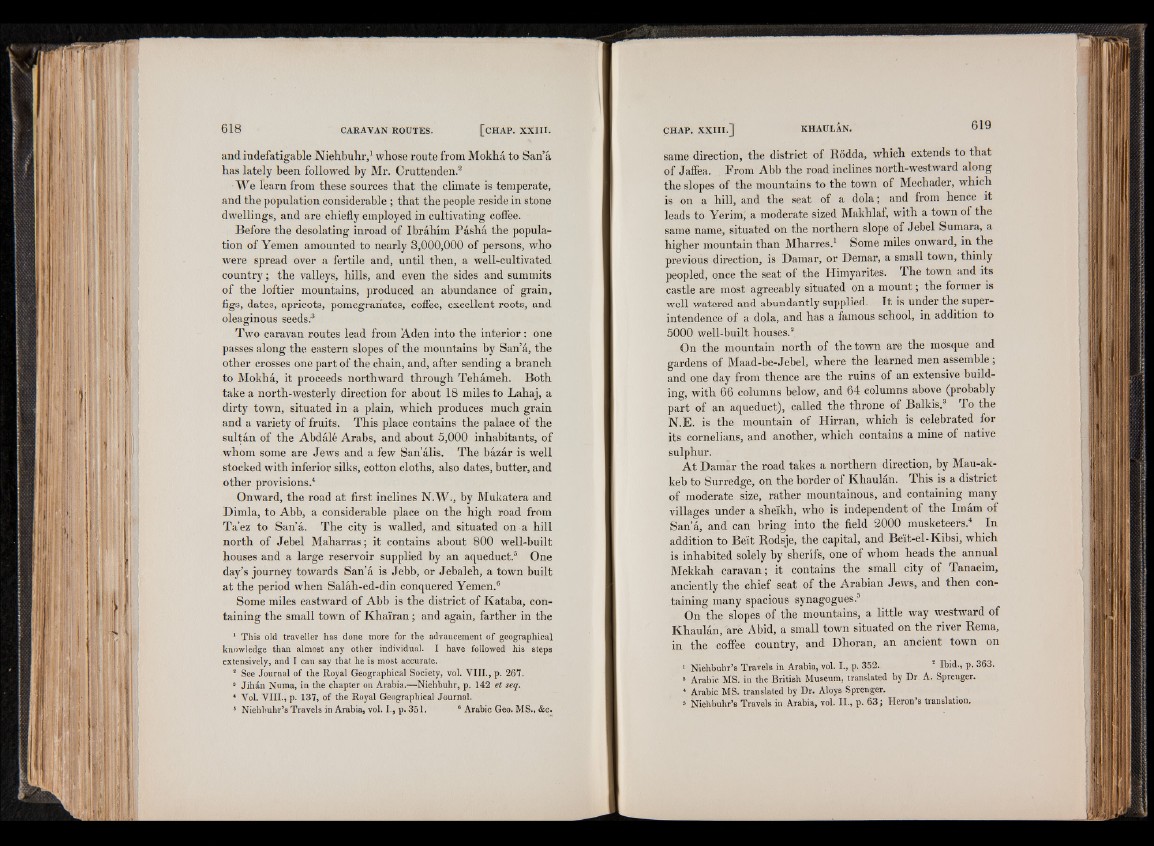
and indefatigable Niehbuhr,1 whose route from Mokha to Sana
has lately been followed by Mr. Cruttenden.3
We learn from these sources that the climate is temperate,
and the population considerable ; that the people reside in stone
dwellings, and are chiefly employed in cultivating coffee.
Before the desolating inroad of Ibrahim Pasha the population
of Yemen amounted to nearly 3,000,000 of persons, who
were spread over a fertile and, until then, a well-cultivated
country; the valleys, hills, and even the sides and summits
of the loftier mountains, produced an abundance of grain,
figs, dates, apricots, pomegranates, coffee, excellent roots, and
oleaginous seeds.3
Two caravan routes lead from Aden into the interior: one
passes along the eastern slopes of the mountains by San’a, the
other crosses one part of the chain, and, after sending a branch
to Mokha, it proceeds northward through Tehameh. Both
take a north-westerly direction for about 18 miles to Lahaj, a
dirty town, situated in a plain, which produces much grain
and a variety of fruits. This place contains the palace of the
sultan of the Abdale Arabs, and about 5,000 inhabitants, of
whom some are Jews and a few San’alis. The bazar is well
stocked with inferior silks, cotton cloths, also dates, butter, and
other provisions.4
Onward, the road at first inclines N.W., by Mukatera and
Dimla, to Abb, a considerable place on the high road from
Ta’ez to Sana. The city is walled, and situated on a hill
north of Jebel Maharras; it contains about 800 well-built
houses and a large reservoir supplied by an aqueduct.5 One
day’s journey towards San’a is Jebb, or Jebaleh, a town built
at the period when Salah-ed-din conquered Yemen.6
Some miles eastward of Abb is the district of Kataba, containing
the small town of Khairan; and again, farther in the
1 This old traveller has done more for the advancement of geographical
knowledge than almost any other individual. I have followed his steps
extensively, and I can say that he is most accurate.
2 See Journal of the Royal Geographical Society, vol. VIII., p. 267.
3 Jihiln Numa, in the chapter on Arabia,—Niehbuhr, p. 142 et seq.
4 Vol. VIII., p. 137, of the Royal Geographical Journal.
3 Niehbuhr’s Travels in Arabia, vol. 1 , p. 351. 6 Arabic Geo. MS., &c.
same direction, the district of Rodda, which extends to that
of Jaffea. From Abb the road inclines north-westward along
the slopes of the mountains to the town of Mechader, which
is on a hill, and the seat of a dola; and from hence it
leads to Yerim, a moderate sized Makhlaf, with a town of the
same name, situated on the northern slope of Jebel Sumara, a
higher mountain than Mharres.1 Some miles onward, in the
previous direction, is Damar, or Demar, a small town, thinly
peopled, once the seat of the Himyarites. The town and its
castle are most agreeably situated on a mount; the former is
well watered and abundantly supplied. It is under the superintendence
of a dola, and has a famous school, in addition to
5000 well-built houses.2,
On the mountain north of the town are the mosque and
gardens of Maad-be-Jebel, where the learned men assemble;
and one day from thence are the ruins of an extensive building,
with 66 columns below, and 64 columns above (probably
part of an aqueduct), called the throne of Balkis.3 To the
N.E. is the mountain of Hirran, which is celebrated for
its cornelians, and another, which contains a mine of native
sulphur.
At Damar the road takes a northern direction, by Mau-ak-
keb to Surredge, on the border of Khaulan. This is a district
of moderate size, rather mountainous, and containing many
villages under a she'ikh, who is independent of the Imam of
Sana, and can bring into the field 2000 musketeers.4 In
addition to Beit Rodsje, the capital, and Be'it-el-Kibsi, which
is inhabited solely by sherifs, one of whom heads the annual
Mekkah caravan; it contains the small city of Tanaeim,
anciently the chief seat of the Arabian Jews, and then containing
many spacious synagogues.5
On the slopes of the mountains, a little way westward of
Khaulán, aré Abid, a small town situated on the river Rema,
in the coffee country, and Dhoran, an ancient town on
1 Niehbuhr’s Travels in Arabia, vol. I., p. 352. Ibid., p. 363.
3 Arabic MS. in the British Museum, translated by Dr. A. Spreuger.
4 Arabic MS. translated by Dr. Aloys Sprenger.
3 Niehbuhr’s Travels in Arabia, vol. II., p. 63 ; Heron’s translation.